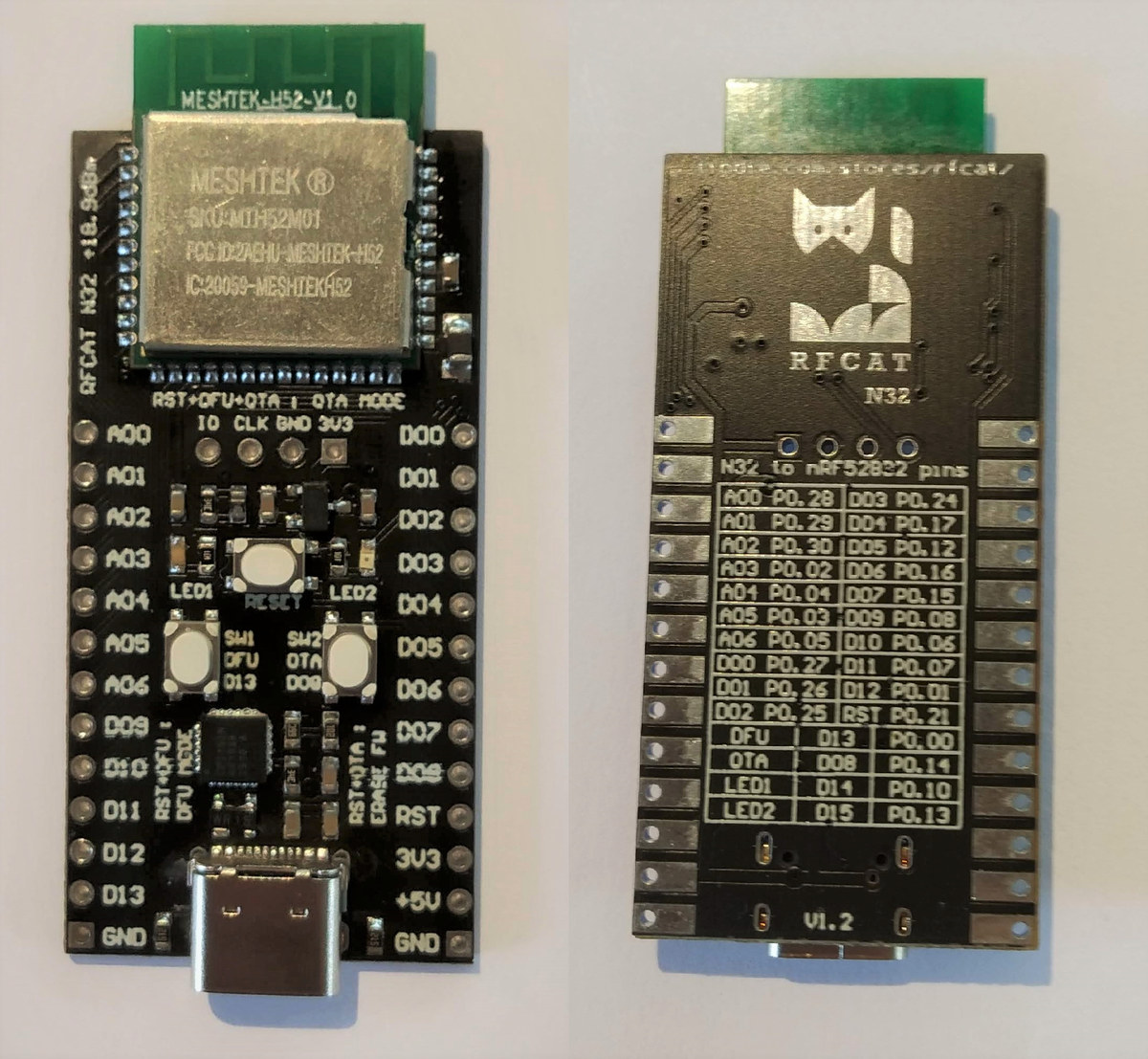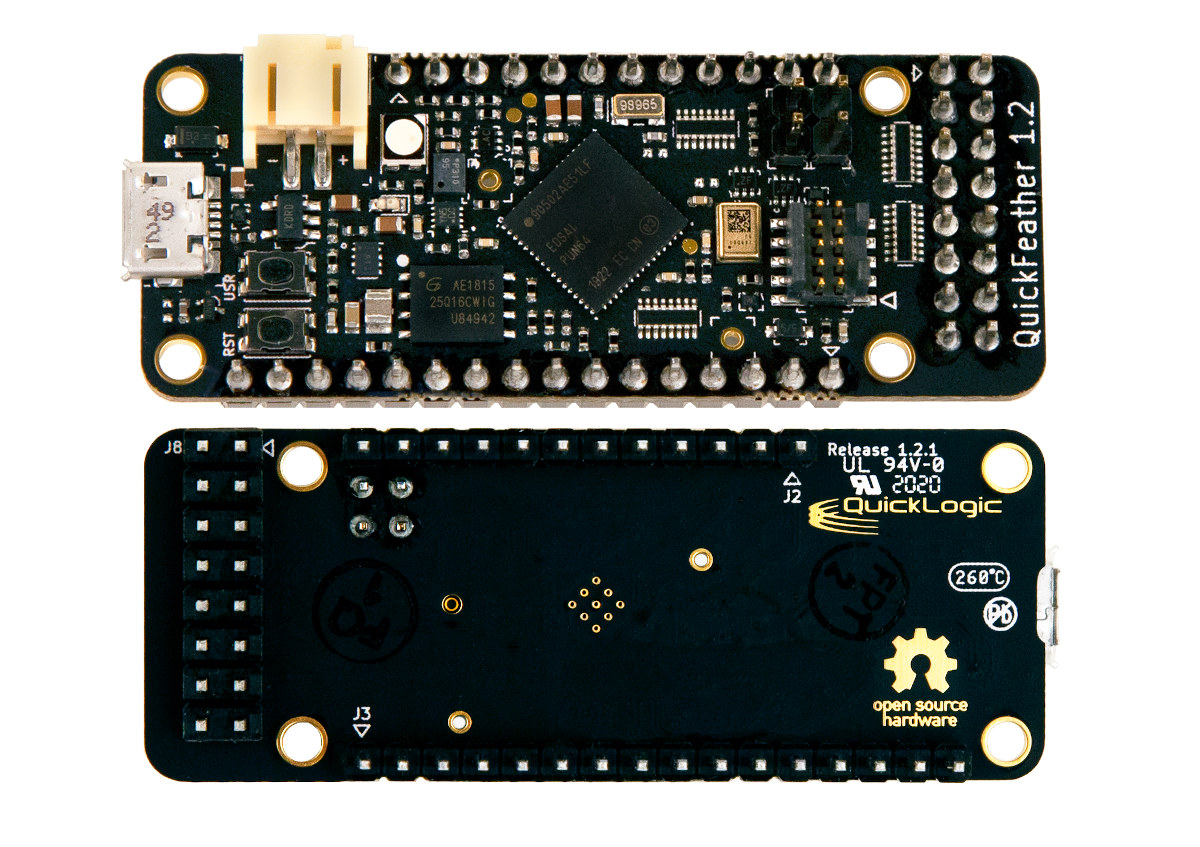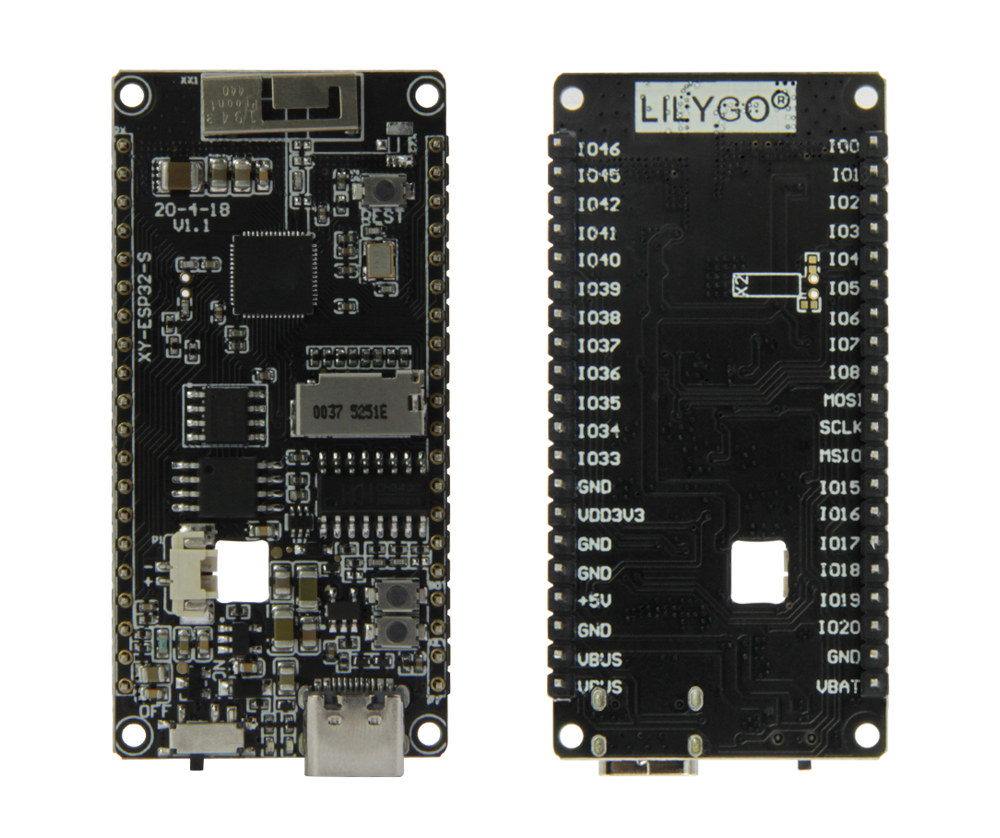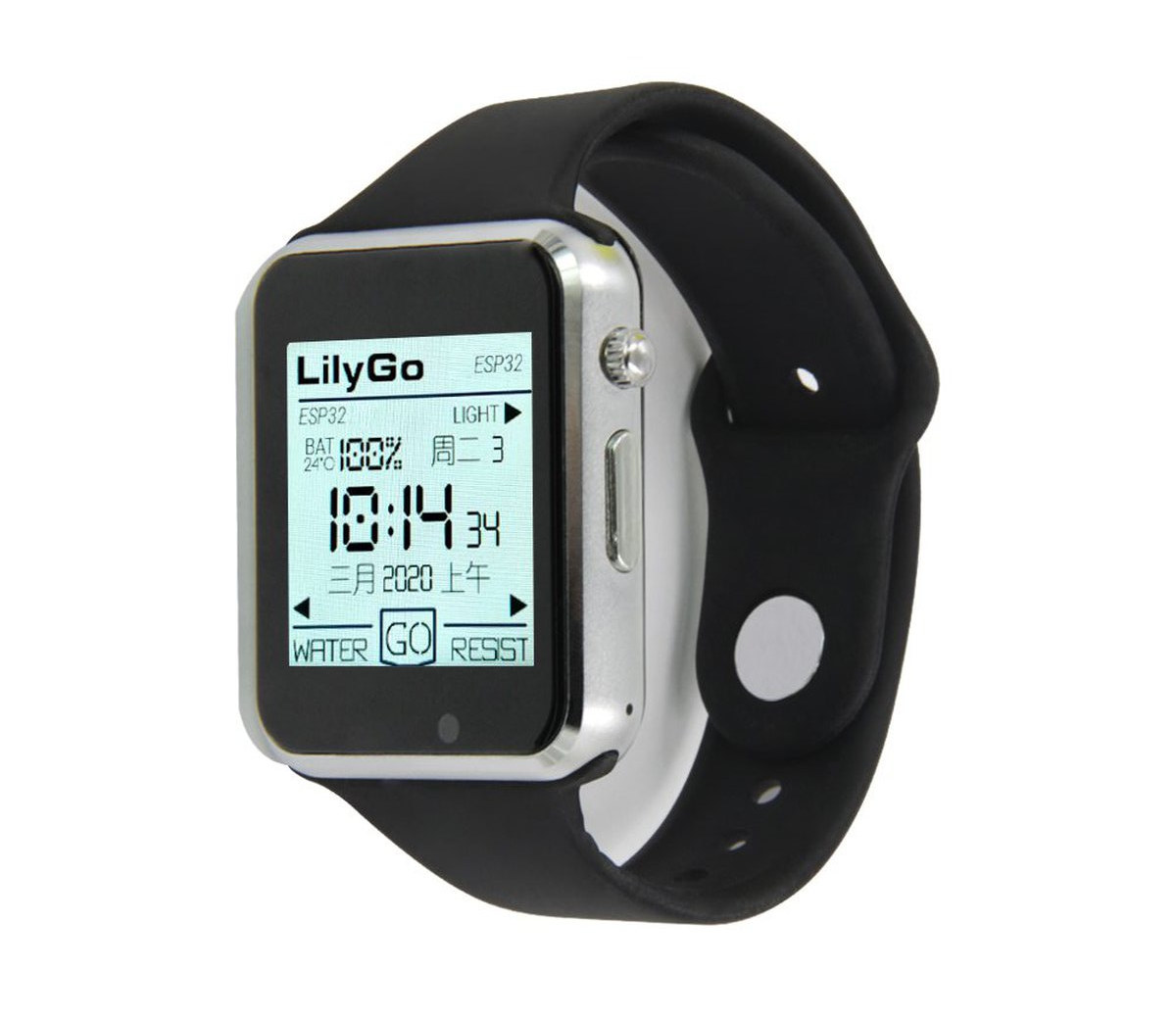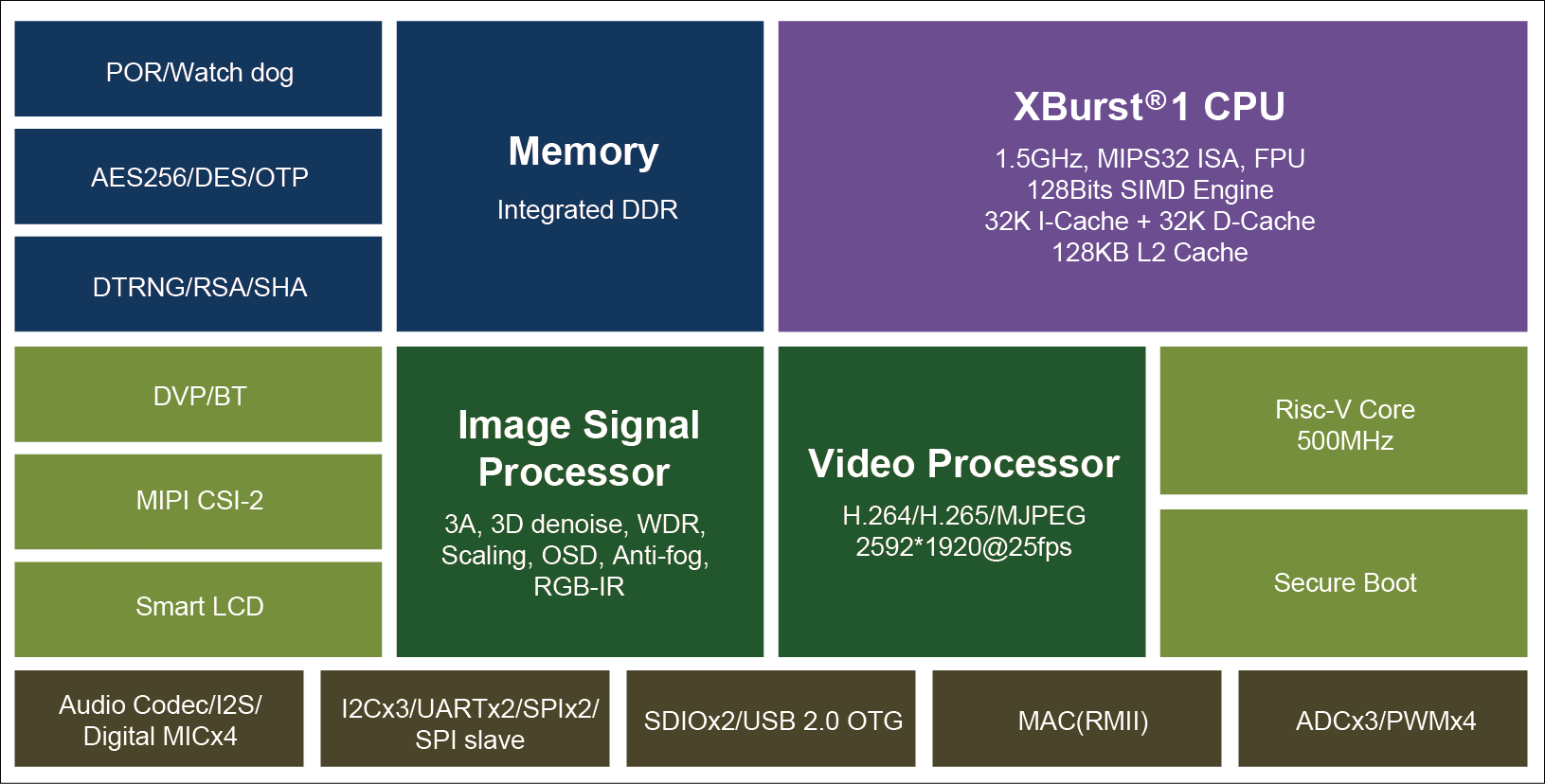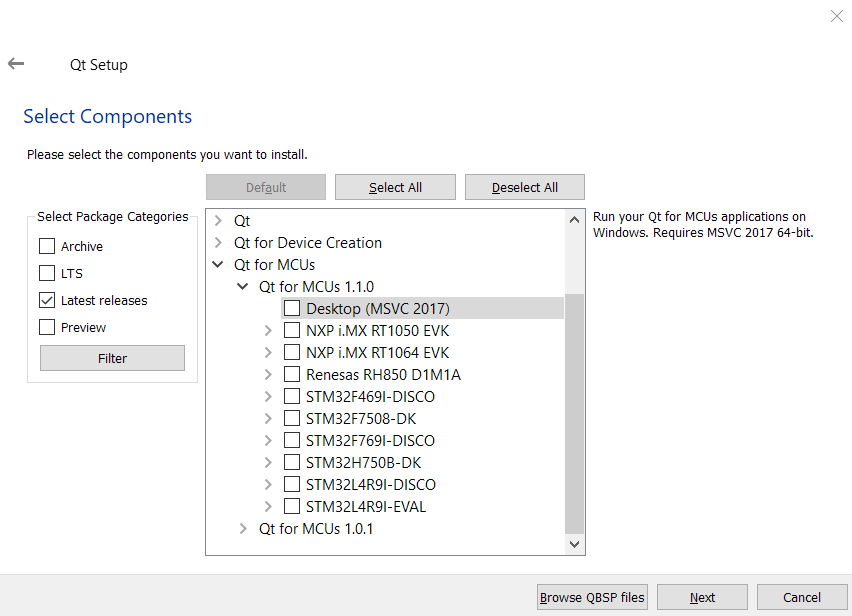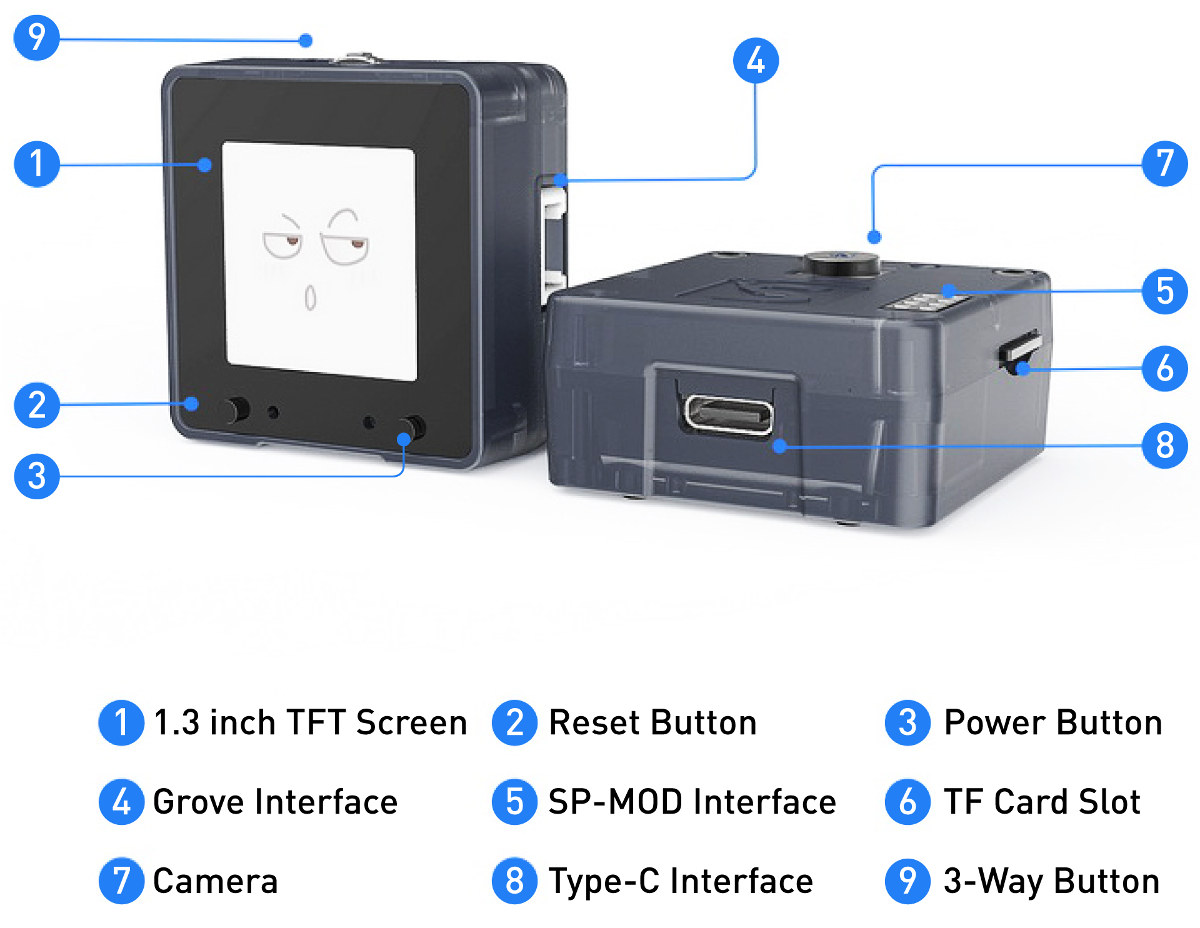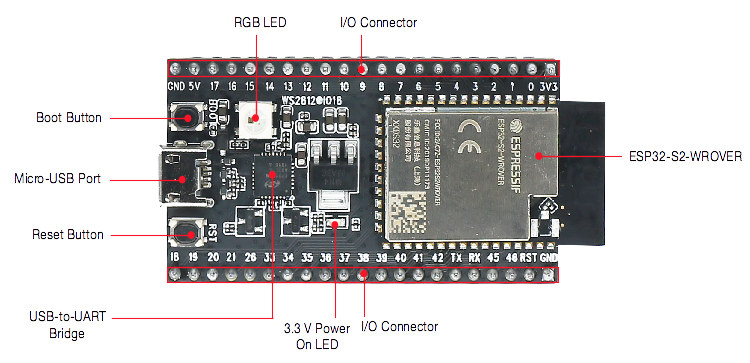Bluetooth 5.0 has two main new features: high speed (2Mbps) and long-range. But as we’ve seen in our nRF52840 vs nRF52832 vs nRF52810 comparison is that only nRF52840 supports Bluetooth 5.x long range. Bluetooth 5 long range is achieved with two new lower bit rates of 500 kbps and 125 kbps. So what do you do if you’d like a longer range and keep using the higher bit rates? You add a power amplifier and LNA to your board, and that’s exactly what Nikolaj (RFCat) did with RFCat N32 board based on Nordic Semi nRF52832 wireless SoC. RFCat N32 board specifications: Wireless module – Meshtek-H52 Smart Mesh Module with integrated PCB antenna based on Nordic Semi nRF52832 Arm Cortex-M4F Bluetooth 5-ready SoC (See datasheet) Skyworks RFX2401C PA &LNA with 18.9dBm TX gain and 11dBm RX gain USB – 1x USB-C port for power, programming and debugging via CP2102N USB to […]
QuickFeather Board is Powered by QuickLogic EOS S3 Cortex-M4F MCU with embedded FPGA (Crowdfunding)
Yesterday, I wrote about what I felt what a pretty unique board: Evo M51 board following Adafruit Feather form factor, and equipped with an Atmel SAMD51 Cortex-M4F MCU and an Intel MAX 10 FPGA. But less than 24 hours later, I’ve come across another Adafruit Feather-sized Cortex-M4F board with FPGA fabric. But instead of using a two-chip solution, QuickLogic QuickFeather board leverages the company’s EOS S3 SoC with a low-power Cortex-M4F core and embedded FPGA fabric. QuickFeather board QuickFeather specifications: SoC – QuickLogic EOS S3 with Arm Cortex-M4F Microcontroller @ up to 80 MHz and 512 Kb SRAM, plus an embedded FPGA (eFPGA) with 2400 effective logic cells and 64Kb RAM Storage – 16Mbit SPI NOR flash USB – Micro USB port with data signals tied to eFPGA programmable logic Sensors – Accelerometer, pressure sensor, built-in PDM microphone Expansion I/Os – Breadboard-compatible 0.1″ (2.54 mm) pitch headers including 20 Feather-defined […]
TTGO ESP32-S2 WiFi IoT Board Comes with Optional MicroSD Card and Battery Support
All ESP32-S2 boards I’ve seen so far were from Espressif Systems themselves including ESP32-S2-Saola-1 and ESP32-S2-Kaluga-1, but LilyGO TTGO ESP32-S2 is the first third-party board for sale so far. The tiny board is somewhat similar to ESP32-S2-Saola-1 board and comes in two versions with a similar form factor, but a completely different pinout and the presence of a MicroSD card socket and a battery connector on one of the boards. The simpler board is called “ESP32-S2 ESP32-S-WOOR” and comes with ESP32-S2-WROOM module, while the one with more features is named “TTGO ESP32-S2 ESP32-S ” and features its own circuitry built around ESP32-S2 WiSoC. Both TTGO ESP32-S2 boards share many of the same specifications: SoC – Espressif Systems ESP32-S2 single-core 32-bit Tensilica LX7 processor with 320 kB SRAM, 128 kB ROM, System Memory – 8MB PSRAM Storage – 4MB flash; XY-ESP32-S only: MicroSD card socket Connectivity 2.4GHz 802.11b/g/n WiFi 4 connectivity […]
Lilygo TTGO T-Watch-2020 is a Nicer Looking Arduino Programmable ESP32 Watch
We’ve covered several ESP32 watches over the last year include TTGO T-Wristand, Watchy, and DSTIKE ESP32 watch. Those don’t really have the nicest looking design, and some people complained about various shortcomings including the difficulty to customize/program the watch. Last year, Lilygo introduced TTGO T-Watch smartwatch that, due to support for expansion boards, was relatively thick, but at least documentation and Arduino code samples can be found on Github. The company has now launched a slicker version with Lilygo TTGO T-Watch-2000. TTGO T-Watch-2020 specifications: SoC – Espressif ESP32 dual-core wireless processor with 520KB SRAM System Memory – 8MB PSRAM Storage – 16MB QSPI flash Display – 1.54-inch LCD capacitive touch screen Audio – Class-D amplifier, buzzer Connectivity – 802.11b/g/n WiFi 4 and Bluetooth 5.1 via ESP32 Sensors – BMA423 three-axis accelerometer with built-in step counting algorithm, activity recognition / tracking, advanced gesture recognition. Misc – Power button (round), PCF8563 RTC […]
Ingenic T31 AI Video Processor Combines MIPS & RISC-V Cores
Last week we asked “is MIPS dead?” question following the news that Wave Computing had filed for bankruptcy, two MIPS Linux maintainers had left, and China-based CIP United now obtained the exclusive MIPS license rights for mainland China, Hong Kong, and Macau. Ingenic is one of those Chinese companies that have offered MIPS-based processors for several years, but one commenter noted that Ingenic joined the RISC-V foundation, and as a result, we could speculate the company might soon launch RISC-V processors, potentially replacing their MIPS offerings. But Ingenic T31 video processor just features both with a traditional Xburst MIPS Core combines with a RISC-V “Lite” core Ingenic T31 specifications: Processors XBurst 1 32-bit MIPS core clocked at 1.5GHz with Vector Deep Learning accelerator based on SIMD128, 64KB + 128KB L1/L2 Cache RISC-V independent lite core System Memory – Built-in 512Mbit (64MB) or 1Gbit (128MB) DDR2 Storage – Quad SPI flash, […]
Qt for MCUs 1.1 Adds Support for more STM32 and NXP i.MX RT Boards, FreeRTOS
The first stable version of Qt for MCUs was released in August 2019 in order to bring Qt graphical toolkit to microcontrollers such as STMicro STM32F7, Renesas RH850, or NXP i.MX RT1050. Qt for MCUs would run bare metal on supported boards, and software engineers would develop graphical interface using QML and C++. Qt for MCUs 1.1 has just been released with the addition of more STM32 and i.MX RT boards, support for FreeRTOS real-time operating system, and more. Qt for MCUs 1.1 highlights: Five new supported boards: NXP i.MX RT 1064 EVK, STM32 H750B-DK, STM32 F469i-disco, STM32 L4R9i-disco, and STM32 L4R9i-eval Asset management Optional PNG compressions for assets to lower storage footprint Option to read data directly from flash memory for lower RAM consumption, or copy to RAM for better performance, at the cost of higher RAM consumption. FreeRTOS support (technology preview) to run background tasks without blocking the […]
Sipeed MaixCube is a Fully Integrated AI Development Platform Powered by Kendryte K210 RISC-V SoC
Sipeed has made several boards and kits based on Kendryte K210 RISC-V processor for low-power AI workloads such as face detection or object recognition including Maixduino board and Grove AI HAT that ship with camera and display. The company has now come up with MaixCube all-in-one development platform that houses Sipeed M1 module, a display, a camera, and a battery into a plastic case that’s somewhat similar to MStack M5StickV but with a larger display, and variations in the form factor and features. Sipeed MaixCube specifications: SoC – Kendryte K210 dual-core 64-bit RISC-V processor @ 400 MHz (overclockable to 600 MHz) with FPU, 8MB SRAM, KPU AI accelerator, APU audio processor, and FFT accelerator Storage – 128 Mbit flash, MicroSD card slot Display – 1.3″ TFT screen with 240×240 resolution Camera – OV7740 sensor (VGA camera) Audio – Built-in microphone, external speakers support; ES8374 audio codec USB – 1x USB […]
ESP32-S2-Saola-1 Development Board is Now Available for $8
Espressif ESP32-S2 WiFi SoC mass production started at the end of February 2020, and soon enough we started to find ESP32-S2 SoC and modules for $1 to $2 on sites like Digikey, but so far we had not seen ESP32-S2 development boards for sale. The good news is the breadboard-friendly ESP32-S2-Saola-1 development board has started to show up for $8 on resellers such as Mouser and Digikey albeit with a lead time of 8 to 12 weeks. ESP32-S2-Saola-1 specifications: Supported modules – ESP32-S2-WROOM(-I) & ESP32-S2-WROVER(-I) with 4 MB SPI flash and for ESP32-S2-WROVER modules only, 2 MB PSRAM USB – 1x Micro USB port for power and programming / debugging via USB-to-UART bridge Expansion – 2x 20-pin I/O headers with SPI, I2S, UART, I2C, touch sensors, PWM, etc… Misc – Boot and reset buttons, RGB LED, 3.3V power on LED Power Supply (3 methods) 5V via Micro USB port (default) […]


